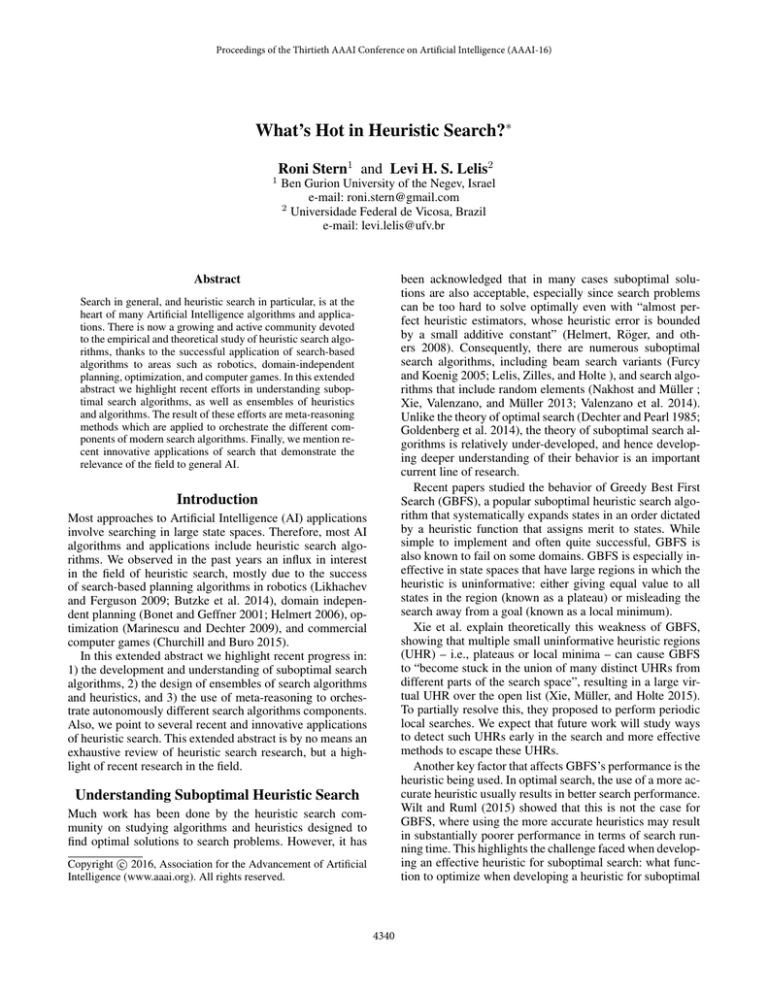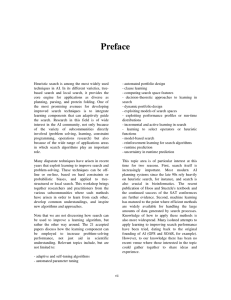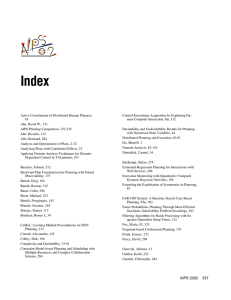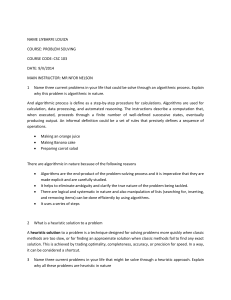
Proceedings of the Thirtieth AAAI Conference on Artificial Intelligence (AAAI-16)
What’s Hot in Heuristic Search?∗
1
Roni Stern1 and Levi H. S. Lelis2
Ben Gurion University of the Negev, Israel
e-mail: roni.stern@gmail.com
2
Universidade Federal de Vicosa, Brazil
e-mail: levi.lelis@ufv.br
been acknowledged that in many cases suboptimal solutions are also acceptable, especially since search problems
can be too hard to solve optimally even with “almost perfect heuristic estimators, whose heuristic error is bounded
by a small additive constant” (Helmert, Röger, and others 2008). Consequently, there are numerous suboptimal
search algorithms, including beam search variants (Furcy
and Koenig 2005; Lelis, Zilles, and Holte ), and search algorithms that include random elements (Nakhost and Müller ;
Xie, Valenzano, and Müller 2013; Valenzano et al. 2014).
Unlike the theory of optimal search (Dechter and Pearl 1985;
Goldenberg et al. 2014), the theory of suboptimal search algorithms is relatively under-developed, and hence developing deeper understanding of their behavior is an important
current line of research.
Recent papers studied the behavior of Greedy Best First
Search (GBFS), a popular suboptimal heuristic search algorithm that systematically expands states in an order dictated
by a heuristic function that assigns merit to states. While
simple to implement and often quite successful, GBFS is
also known to fail on some domains. GBFS is especially ineffective in state spaces that have large regions in which the
heuristic is uninformative: either giving equal value to all
states in the region (known as a plateau) or misleading the
search away from a goal (known as a local minimum).
Xie et al. explain theoretically this weakness of GBFS,
showing that multiple small uninformative heuristic regions
(UHR) – i.e., plateaus or local minima – can cause GBFS
to “become stuck in the union of many distinct UHRs from
different parts of the search space”, resulting in a large virtual UHR over the open list (Xie, Müller, and Holte 2015).
To partially resolve this, they proposed to perform periodic
local searches. We expect that future work will study ways
to detect such UHRs early in the search and more effective
methods to escape these UHRs.
Another key factor that affects GBFS’s performance is the
heuristic being used. In optimal search, the use of a more accurate heuristic usually results in better search performance.
Wilt and Ruml (2015) showed that this is not the case for
GBFS, where using the more accurate heuristics may result
in substantially poorer performance in terms of search running time. This highlights the challenge faced when developing an effective heuristic for suboptimal search: what function to optimize when developing a heuristic for suboptimal
Abstract
Search in general, and heuristic search in particular, is at the
heart of many Artificial Intelligence algorithms and applications. There is now a growing and active community devoted
to the empirical and theoretical study of heuristic search algorithms, thanks to the successful application of search-based
algorithms to areas such as robotics, domain-independent
planning, optimization, and computer games. In this extended
abstract we highlight recent efforts in understanding suboptimal search algorithms, as well as ensembles of heuristics
and algorithms. The result of these efforts are meta-reasoning
methods which are applied to orchestrate the different components of modern search algorithms. Finally, we mention recent innovative applications of search that demonstrate the
relevance of the field to general AI.
Introduction
Most approaches to Artificial Intelligence (AI) applications
involve searching in large state spaces. Therefore, most AI
algorithms and applications include heuristic search algorithms. We observed in the past years an influx in interest
in the field of heuristic search, mostly due to the success
of search-based planning algorithms in robotics (Likhachev
and Ferguson 2009; Butzke et al. 2014), domain independent planning (Bonet and Geffner 2001; Helmert 2006), optimization (Marinescu and Dechter 2009), and commercial
computer games (Churchill and Buro 2015).
In this extended abstract we highlight recent progress in:
1) the development and understanding of suboptimal search
algorithms, 2) the design of ensembles of search algorithms
and heuristics, and 3) the use of meta-reasoning to orchestrate autonomously different search algorithms components.
Also, we point to several recent and innovative applications
of heuristic search. This extended abstract is by no means an
exhaustive review of heuristic search research, but a highlight of recent research in the field.
Understanding Suboptimal Heuristic Search
Much work has been done by the heuristic search community on studying algorithms and heuristics designed to
find optimal solutions to search problems. However, it has
c 2016, Association for the Advancement of Artificial
Copyright Intelligence (www.aaai.org). All rights reserved.
4340
Decision Making in Heuristic Search
search? Wilt and Ruml proposed to measure the rank correlation between the used heuristic and the shortest distance to
a goal. This correlation, named Goal Distance Rank Correlation (GDRC), was able to predict in some cases GBFS’s
performance, but we expect further research along this line.
As search algorithms become more complex, using ensembles of heuristics, operator orderings, and other algorithmic
variations, there is a growing importance in deciding when
to apply which algorithmic component.
Recent work apply rational meta-reasoning to select
which set of heuristic to apply to evaluate a given state for
A* (Tolpin et al. 2013) and for IDA* (Betzalel, Felner, and
Shimony 2015; Tolpin et al. ), showing significant gains. A
different application of meta-reasoning is for cases where
the searching agent can interleave planning and execution.
The meta-reasoning here is to decide how much searching to
do before committing to the execution of an action, aiming
to minimize the goal achievement time – the overall computation and execution time of reaching a goal (O’Ceallaigh
and Ruml 2015). In a similar line of research, Barley et
al. (2014) developed a meta-reasoning system for selecting a subset of heuristic functions while minimizing the
A* running time in domain-independent planning problems.
Rayner et al. (2013) showed how to make near-optimal selection of heuristic subsets on map-based pathfinding problems. Recent advancements in predicting the running time
of search algorithms developed by Lelis et al. (2013; 2013;
2014) can provide the facilitative technologies for metareasoning tasks such as deciding which search strategy will
find the goal the quickest. Generally, we believe that applying AI decision making algorithms to develop more intelligent search algorithms is a promising research direction.
Ensembles and Portfolios
It is known that heuristic search algorithms can benefit from the information provided by multiple heuristic
functions. Traditional methods for using multiple heuristic
functions aggregate the values returned by all the heuristics to a single value, e.g., by summing the values (Felner, Korf, and Hanan 2004), taking their max (Korf 1997;
Holte et al. 2006), or more sophisticated mechanisms for
aggregating multiple heuristics (Katz and Domshlak 2010;
Pommerening et al. 2015). Recent work (Röger and Helmert
2010) has observed, especially when finding optimal solutions is not needed, that it is often more helpful to preserve
the ordering induced by each heuristic function instead of
aggregating their absolute value.
One way of preserving the ordering induced by several
heuristic functions is to maintain several open lists, each ordered by a different heuristic function, and in every expansion cycle choose to expand a node from a different open list.
This extends traditional best-first search algorithms such as
A* (Hart, Nilsson, and Raphael 1968), which operates a single open list sorted according to the information provided by
a single heuristic. Current state-of-the-art planners use this
multiple open list approach (Röger and Helmert 2010). Recently, the idea was introduced and extended in search-based
robotic planners, providing also theoretical guarantees on
solution quality and search complexity even when using an
arbitrarily large set of admissible and inadmissible heuristics (Phillips et al. 2015; Narayanan, Aine, and Likhachev
2015).
This direction of research opens the way for applying a
range of techniques used in other sub-fields of AI when considering multiple sources of information. Prior work has already used genetic algorithms to choose the best combination of heuristics (Elyasaf and Sipper 2013), but one can
consider adapting any feature selection methods from the
machine learning literature, viewing heuristics as features
and search effort as classification error. Alternatively, one
may consider applying boosting methods, which are popular
in the construction of ensemble of classifiers. A preliminary
example of this was done by Richter and Helmert (2009).
In addition to combining multiple heuristics, another effective strategy is to use a set of different search algorithms
in what is known as a search portfolio. For example, Fast
Downward Stone Soup is system that sequentially runs different instances of the Fast Downward planner, with each instance being run for a fixed amount of time (Helmert, Röger,
and Karpas 2011). As another example, ArvandHerd runs
multiple search algorithms with different strategies in parallel (Valenzano et al. 2011). Recently, Seipp et al. (2015)
presented an algorithm that automatically chooses the configuration of a portfolio planner, i.e., how much time to allocate to each of the planners in the portfolio.
Novel Applications
With the dissemination of AI into everyday life, recent years
have shown many new applications of heuristic search algorithms to novel domains. These domains include feature
selection for clustering algorithms (Mariño and Lelis 2015),
anomaly detection for cyber-security (Mirsky et al. 2015),
finding error-correction codes (Palombo et al. 2015), a Kivalike domain for multi-agent pathfinding (Cohen, Uras, and
Koenig 2015), Maximum a Posteriori Estimation in Probabilistic Programs (Tolpin and Wood 2015), an AI player of
a commercial video game which accounts for the player’s
enjoyment (Churchill and Buro 2015), and automated discovery of chemical compounds (Heifets and Jurisica 2012).
These applications of heuristic search theory and algorithms provides yet another demonstration of the impact of
researching heuristic search methods.
Conclusions
While heuristic search is a mature sub-field of AI, there
are many fundamental research challenges being addressed
these days. In this brief review we covered recent progress in
the understanding of suboptimal search algorithms, the design and use of heuristic ensembles, and more generally the
application of meta-reasoning in guiding search algorithms.
Acknowledgments
We thank Ariel Felner, Robert Holte, Wheeler Ruml, and
Malte Helmert for their helpful comments.
4341
References
Lelis, L. H.; Zilles, S.; and Holte, R. C. 2013. Predicting the size
of IDA* ’s search tree. Artificial Intelligence 196:53–76.
Likhachev, M., and Ferguson, D. 2009. Planning long dynamically
feasible maneuvers for autonomous vehicles. International Journal
of Robotics Research 28(8):933–945.
Marinescu, R., and Dechter, R. 2009. Memory intensive and/or
search for combinatorial optimization in graphical models. Artif.
Intell. 173(16-17):1492–1524.
Mariño, J. R., and Lelis, L. H. 2015. Feature selection as statespace search: An empirical study in clustering problems. In Symposium on Combinatorial Search (SoCS).
Mirsky, Y.; Cohen, A.; Stern, R.; Felner, A.; Rokach, L.; Elovici,
Y.; and Shapira, B. 2015. Search problems in the domain of multiplication: Case study on anomaly detection using markov chains.
In Symposium on Combinatorial Search (SOCS), 70–77.
Nakhost, H., and Müller, M. Towards a second generation random
walk planner: an experimental exploration. In IJCAI.
Narayanan, V.; Aine, S.; and Likhachev, M. 2015. Improved multiheuristic a* for searching with uncalibrated heuristics. In Symposium on Combinatorial Search (SoCS).
O’Ceallaigh, D., and Ruml, W. 2015. Metareasoning in real-time
heuristic search. In Symposium on Combinatorial Search (SOCS).
Palombo, A.; Stern, R.; Puzis, R.; Felner, A.; Kiesel, S.; and Ruml,
W. 2015. Solving the snake in the box problem with heuristic search: First results. In Symposium on Combinatorial Search
(SOCS), 96–104.
Phillips, M.; Narayanan, V.; Aine, S.; and Likhachev, M. 2015.
Efficient search with an ensemble of heuristics. IJCAI.
Pommerening, F.; Helmert, M.; Röger, G.; and Seipp, J. 2015.
From non-negative to general operator cost partitioning. AAAI.
Rayner, D. C.; Sturtevant, N. R.; and Bowling, M. 2013. Subset
selection of search heuristics. In IJCAI, 637–643.
Richter, S., and Helmert, M. 2009. Preferred operators and deferred
evaluation in satisficing planning. In ICAPS, 273–280.
Röger, G., and Helmert, M. 2010. The more, the merrier: Combining heuristic estimators for satisficing planning. In ICAPS.
Seipp, J.; Sievers, S.; Helmert, M.; and Hutter, F. 2015. Automatic
configuration of sequential planning portfolios. In AAAI.
Tolpin, D., and Wood, F. 2015. Maximum a posteriori estimation
by search in probabilistic programs. In Symposium on Combinatorial Search (SOCS), 201–205.
Tolpin, D.; Betzalel, O.; Felner, A.; and Shimony, S. E. Rational
deployment of multiple heuristics in IDA*. In ECAI.
Tolpin, D.; Beja, T.; Shimony, S. E.; Felner, A.; and Karpas, E.
2013. Toward rational deployment of multiple heuristics in A*. In
IJCAI.
Valenzano, R.; Nakhost, H.; Müller, M.; Schaeffer, J.; and Sturtevant, N. 2011. Arvandherd: Parallel planning with a portfolio. In
IPC 2011 Deterministic Track, 113–116.
Valenzano, R.; Schaeffer, J.; Sturtevant, N.; and Xie, F. 2014.
A comparison of knowledge-based gbfs enhancements and
knowledge-free exploration. In ICAPS, 375–379.
Wilt, C. M., and Ruml, W. 2015. Building a heuristic for greedy
search. In Symposium on Combinatorial Search (SoCS).
Xie, F.; Müller, M.; and Holte, R. 2015. Understanding and improving local exploration for gbfs. In ICAPS.
Xie, F.; Valenzano, R. A.; and Müller, M. 2013. Better time constrained search via randomization and postprocessing. In ICAPS.
Barley, M.; Franco, S.; and Riddle, P. 2014. Overcoming the utility
problem in heuristic generation: Why time matters. In ICAPS, 38–
46.
Betzalel, O.; Felner, A.; and Shimony, S. E. 2015. Type system
based rational lazy IDA*. In Symposium on Combinatorial Search
(SOCS).
Bonet, B., and Geffner, H. 2001. Planning as heuristic search.
Artif. Intell. 129(1-2):5–33.
Butzke, J.; Sapkota, K.; Prasad, K.; MacAllister, B.; and Likhachev,
M. 2014. State lattice with controllers: Augmenting lattice-based
path planning with controller-based motion primitives. In International Conference on Intelligent Robots and Systems (IROS), 258–
265. IEEE.
Churchill, D., and Buro, M. 2015. Hierarchical portfolio search:
Prismata’s robust ai architecture for games with large search
spaces. In AIIDE.
Cohen, L.; Uras, T.; and Koenig, S. 2015. Feasibility study: Using highways for bounded-suboptimal multi-agent path finding. In
Symposium on Combinatorial Search (SOCS), 2–8.
Dechter, R., and Pearl, J. 1985. Generalized best-first search strategies and the optimality of A*. Journal of the ACM 32(3):505–536.
Elyasaf, A., and Sipper, M. 2013. HH-evolver: a system for
domain-specific, hyper-heuristic evolution. In conference companion on genetic and evolutionary computation (GECCO).
Felner, A.; Korf, R. E.; and Hanan, S. 2004. Additive pattern
database heuristics. J. Artif. Intell. Res. (JAIR) 22:279–318.
Furcy, D., and Koenig, S. 2005. Limited discrepancy beam search.
In IJCAI, 125–131.
Goldenberg, M.; Felner, A.; Stern, R.; Sharon, G.; Sturtevant,
N. R.; Holte, R. C.; and Schaeffer, J. 2014. Enhanced partial expansion A. J. Artif. Intell. Res. (JAIR) 50:141–187.
Hart, P. E.; Nilsson, N. J.; and Raphael, B. 1968. A formal basis for
the heuristic determination of minimum cost paths. IEEE Transactions on Systems Science and Cybernetics SCC-4(2):100–107.
Heifets, A., and Jurisica, I. 2012. Construction of new medicines
via game proof search. In AAAI, 1564–1570.
Helmert, M.; Röger, G.; and Karpas, E. 2011. Fast downward stone
soup: A baseline for building planner portfolios. In Workshop on
Planning and Learning, ICAPS, 28–35.
Helmert, M.; Röger, G.; et al. 2008. How good is almost perfect?
In AAAI, volume 8, 944–949.
Helmert, M. 2006. The fast downward planning system. J. Artif.
Intell. Res. (JAIR) 26:191–246.
Holte, R. C.; Felner, A.; Newton, J.; Meshulam, R.; and Furcy,
D. 2006. Maximizing over multiple pattern databases speeds up
heuristic search. Artificial Intelligence 170:1123–1136.
Katz, M., and Domshlak, C. 2010. Optimal admissible composition of abstraction heuristics. Artif. Intell. 174(12-13).
Korf, R. E. 1997. Finding optimal solutions to rubik’s cube using
pattern databases. In AAAI/IAAI, 700–705.
Lelis, L. H.; Otten, L.; and Dechter, R. 2013. Predicting the size of
depth-first branch and bound search trees. In IJCAI, 594–600.
Lelis, L. H.; Otten, L.; and Dechter, R. 2014. Memory-efficient tree
size prediction for depth-first search in graphical models. In Principles and Practice of Constraint Programming (CP), 481–496.
Lelis, L. H.; Zilles, S.; and Holte, R. C. Stratified tree search: a
novel suboptimal heuristic search algorithm. In AAMAS.
4342









